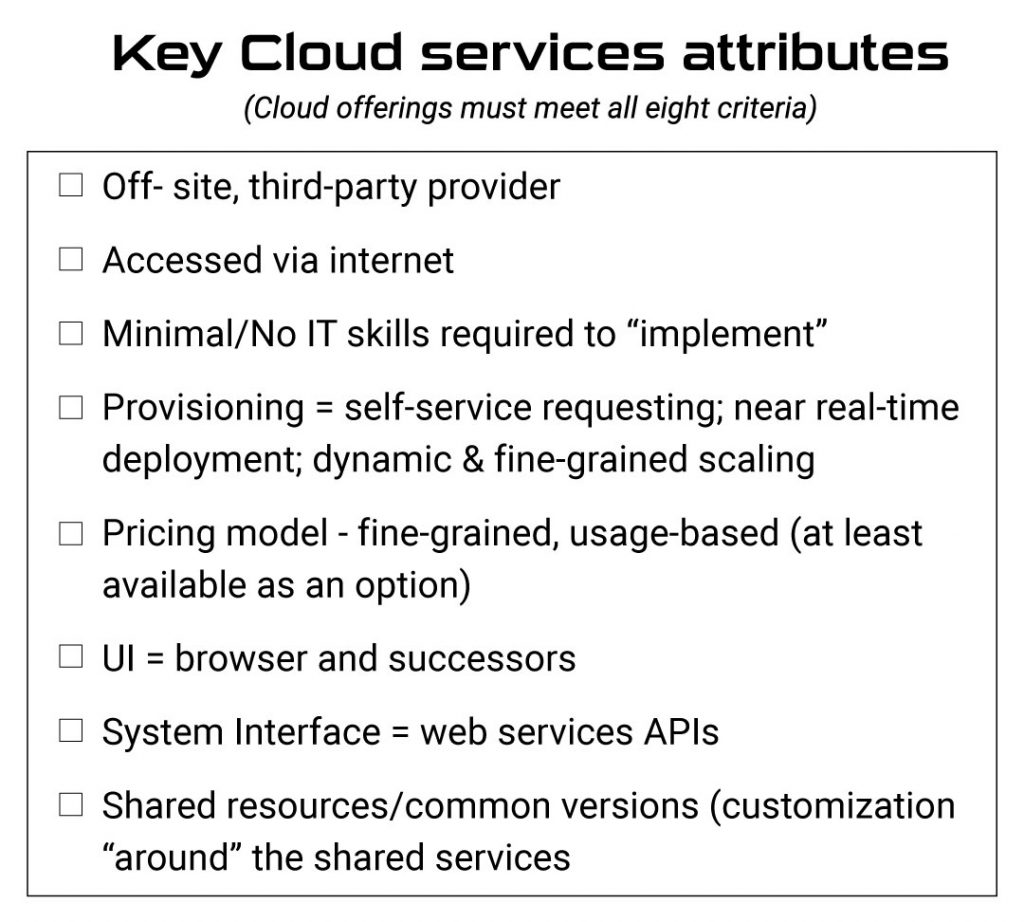“Cloud Computing” versus “Cloud Services”
When most people talk about “Cloud Computing”, they usually refer to online delivery and consumption models for business and consumer services. These services include IT services – like software-as-a-service (SaaS) and storage or server capacity as a service – but also many, many “non-IT” business and consumer services. The vast majority of these online services are not, in the mind of the user, IT or “computing” at all – they are about shopping, banking, selling, collaborating, communicating, being entertained, etc. In other words, most people using these services are not “computing”, they are living! These customers are not explicitly buying “Cloud Computing”, but the “Cloud Services” that are enabled by Cloud Computing environments; Cloud Computing is hidden underneath the business or consumer service. And so, in our definitional framework, we distinguish between:
Cloud Services: Consumer and Business products, services and solutions that are delivered and consumed in real-time over the Internet
Cloud Computing: an emerging IT development, deployment and delivery model, enabling real-time delivery of products, services and solutions over the Internet (i.e., enabling Cloud Services)
Essentially, a Cloud Service is any business or consumer service that is delivered and consumed over the Internet in real-time (that’s the 5 second definition; more important detail below). Cloud Computing, an important, but much narrower term, is the IT environment – encompassing all elements of the full “stack” of IT and network products (and supporting services) – that enables the development, delivery and consumption of Cloud Services.
Any discussion of Cloud computing must start with a discussion of what the attributes of Cloud services are, and – consequently – what attributes Cloud Computing environments need to enable.
The vast majority of these online services are not, in the mind of the user, IT or “computing” at all – they are about shopping, banking, selling, collaborating, communicating, being entertained, etc. In other words, most people using these services are not “computing”, they are living! These customers are not explicitly buying “Cloud Computing”, but the “Cloud Services” that are enabled by Cloud Computing environments; Cloud Computing is hidden underneath the business or consumer service. And so, in our definitional framework, we distinguish between:
Cloud Services: Consumer and Business products, services and solutions that are delivered and consumed in real-time over the Internet
Cloud Computing: an emerging IT development, deployment and delivery model, enabling real-time delivery of products, services and solutions over the Internet (i.e., enabling Cloud Services)
Essentially, a Cloud Service is any business or consumer service that is delivered and consumed over the Internet in real-time (that’s the 5 second definition; more important detail below). Cloud Computing, an important, but much narrower term, is the IT environment – encompassing all elements of the full “stack” of IT and network products (and supporting services) – that enables the development, delivery and consumption of Cloud Services.
Any discussion of Cloud computing must start with a discussion of what the attributes of Cloud services are, and – consequently – what attributes Cloud Computing environments need to enable.
What Are “Cloud Services”? An Eight-Point Checklist
What Are “Cloud Services”? An Eight-Point Checklist I recently received a reader comment that suggested that Cloud Computing and Cloud Services are just a rehash of the same old stuff: “One thing 30 years in the IT industry has taught me is that the more things change, the more they stay the same. Another is that the only memory we seem to access is short-term. Yet another is that techno-marketers rely on that, so they can put labels like ‘revolutionary’ and ‘innovative’ on platforms, products and services that are mere re-inventions of the wheel and often poor copies at that. A good example is all the buzz about ‘Cloud Computing’” This reader and other skeptics cite prior industry models and offerings, like service bureaus, mainframes, virtualization, application service providers (ASPs), et al., as having already delivered much that is promised through the Cloud model. But these perspectives miss the critical differences that define the new and substantial benefits Cloud Services offer. Surveying the wide range of Cloud offerings, here are eight attributes that, in our view, define the new generation of commercial Cloud Services, and provide the basis for those benefits:
- Offsite, provided by third-party provider - In the Cloud” execution, which for most practical purposes means offsite (really, location-agnostic). Specifying “third-party provider” simply highlights that the services we’re focused on in our analysis are commercial Cloud Services. [CIOs could implement the Cloud model within their own organization, for use by their own employees, something referred to as an "enterprise Cloud". And, indeed, we expect many will, as the next step in their transition to a next-generation, "Dynamic IT" services delivery model. For those who want to include "in-house" Cloud Services delivery in their market view, they can simply eliminate the "third-party provider" attribute.]
- Accessed via the Internet - standards-based, universal network access. This does not preclude service providers offering security or quality-of-service value-added options.
- Minimal/no IT skills to “implement” - online, simplified specification of services requirements; need is eliminated for lengthy implementation services for on-premise systems that support the service (the service provider offloads this).
- Provisioning - self-service requesting, near real-time deployment, dynamic & fine-grained scaling.
- Pricing - fine-grained & usage-based pricing capability. (As a convenience to some customers, providers may mask this pricing granularity with long-term, fixed price agreements.)
- User Interface - browser & successors. Browsers will evolve, for a wider variety of devices, and with richer capabilities. But the basic aspects of a browser ? intuitive/easy-to-use, standards-based, application/service-independent, multi-platform ? remain the attributes of Cloud Services UIs.
- System Interface - Web services APIs, providing a standards-based framework for accessing and integrating with and among Cloud Services (and web services-based/enabled in-house systems). In our view, this is a critically important aspect of Cloud Services: that they provide well-defined, programmatic access for users, partners and others who want to leverage the Cloud Service within a broader solution context.
- Shared resources/common versions - the shared asset approach improves supplier and customer economics; there is some ability to customize “around” the shared services, via configuration options within the service, workflow/process management among services, et al.
What, Then, Is “Cloud Computing”?
Since Cloud Computing is the IT foundation for Cloud Services, it consists of a growing list of technologies and IT offerings that enable Cloud Services, as defined by the attributes listed above. A partial list includes:- Infrastructure systems (e.g., servers, storage, networks) that can economically scale to very high volumes, and preferably do so in a granular fashion.
- Application software that provides web-based UIs, web services APIs, multi-tenant architecture and a rich variety of configuration options.
- Application development and deployment software that supports the development, integration or runtime execution of Cloud application software.
- System and application management software that supports rapid self-service provisioning and configuration, usage monitoring, et al.
- IP Networks that connect end users to “the Cloud” and the infrastructure components of the Cloud to each other, leveraging network-embedded technologies for quality-of-service, security, and optimized application delivery.
Link to original article
CONEXPO-CON/AGG 2020
It’s Time to Get Your Head in the Cloud!
Sysdyne is Attending CONEXPO-CON/AGG in Las Vegas March 10-14.

Come See How the Cloud Is Revolutionizing Our Industry!
Sysdyne is a proven leader in cloud-based solutions for the ready-mix concrete industry. Our cloud-based Batch, Dispatch and Delivery Management platforms, backed by 24/7 customer support, help producers cut costs and improve operations to be more competitive and make their life easier.
Track key production, delivery, quality and driver performance using your phone or tablet, making it easier to make important decisions, in real time. Everything you need at your fingertips to help grow your business.
![]()
Sysdyne is presenting at the CONEXPO, in Las Vegas, NV, March 10-14, 2020 at BOOTH #S63111. It will be a great opportunity to meet up with our valued customers who we consider family. Come out and see how the cloud can really benefit your business.
We look forward to seeing you there!

